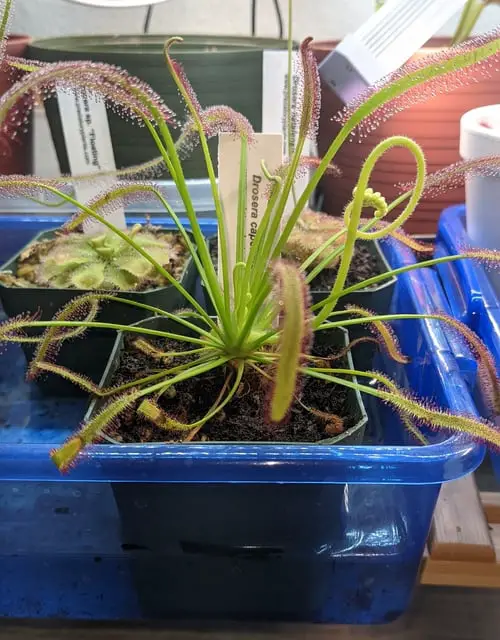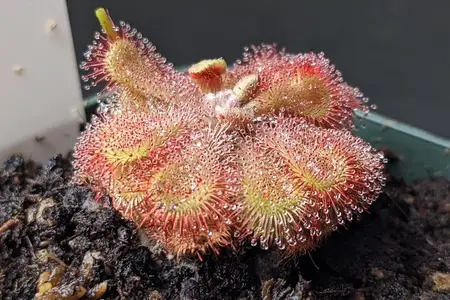As a proud Sundew owner, I like to give my plants code names to identify them and to have a bit of fun.
I have made an extensive list of some name ideas for Drosera plants. Some names are associated with the name Drosera, others with Sundew or something in between. I hope the list serves you as an inspiration to name your plant. Some names are inspired by types of Sundew, such as binata, cape sundew, or spoon-leaf.
Here is a list of 49 Sundew name ideas:
- Dewie or dew
- Sunny D
- Bed head
- Mist or Misty
- Tangela (for the Pokemon fans)
- Mr Dew
- Sticky or Stick
- Gum
- Bug killer
- Flubber
- Crazy hair
- Risky Business
- Bug Threat
- Adhesive
- Glue
- Molasses
- Sunny or Sun
- [Inser bug name] Terminator or just Terminator
- Octopus
- Little Tree (great match for cape sundew)
- Mr. Palm
- Tentacles
- Medusa
- Gorgon or Gorgona
- Adele
- Capi
- Forrest
- Curls or Curly
- Lollipop
- Fork (great match for binata)
- Y Plant or Why Plant (also great for binata)
- Death wish
- Red or Reddish
- Magenta
- Drop or droplets
- Savage or Savage Flower
- Gnarly
- Ant Eater
- Dron or Drona
- Drooti
- Droo
- Drorit
- Sera (short from Drosera
- Sphagetti
- String
- Snake
- Sol
- Spot
- Sue
I included several names that are a perfect fit for Cape Sundew since it is one of my favorite Sundews. Here is a picture of mine flowering a few months back.

The scientific name for Sundew plants is Drosera. The names Drosera or Sundew are used interchangeably. Currently, there are over 190 species of Drosera growing all over the world. Some common species are the Cape Sundew, Drosera Binata, Spoon-leaf Sundew, and Drosera Adelae.
Besides the scientific name, many people consider naming or taking their plant to create a connection and keep track of their needs. After choosing a name, make sure to write down essential care details, such as:
- What variety do you own?
- When did you get it?
- Last repot date
- Dormancy requirements
- General state/ health of the plant through the seasons
After exploring the names, make sure to read the sections below and learn more about Sundew care, as keeping them alive and healthy can be a bit of a challenge.
Sundew Care for Beginners
This short guide explains the essential consideration you should keep in mind when growing Drosera. Read over all the items and pay close attention to the soil, watering, and lighting requirements, as those are incredibly critical.
Soil: Avoid standard soil mixes at all costs. Instead, employ carnivorous plant potting media. There are many different types of carnivorous plant media, but they have one thing in common: little to no mineral content.
You can buy carnivorous plant soil online or make it yourself. You must combine pure perlite or sphagnum moss with silica sand and/or perlite to make the soil. Here is a link to high-quality carnivorous plant soil you can buy online.
Lighting: Sundews need sunny environments to stay healthy. They can grow well under artificial or natural light as long as they have exposure to extended hours of lighting. Provide a minimum of 6 hours of light exposure every day. And, if possible, aim for 12+ hours of light. If you plan to employ artificial lighting, here are a few lights I have used for my Sundews and other carnivorous plants:
- Small plant light for 1-4 plants: https://amzn.to/2RsGlxr
- T8 LED light fixture for multiple plants (6500k Cool White): https://amzn.to/3uWoeh2
Watering requirements: Water your sundew with reverse osmosis water, distilled water, or rainwater exclusively. Never water your sundew with tap water or bottled water. Drosera needs water with little to no mineral content.
Consider employing the water tray method to keep the soil wet all the time. You can get the full instructions on effectively watering your plant in this article: Sundew Watering.
Feeding: Sundews grow larger and healthier when they have access to bugs. Sundews living outdoors capture their own food, but indoor plants might require your help. Use live bugs or rehydrated dead bugs to feed your plant every 2-4 weeks.
Use of Fertilizers: Mixing fertilizers and sundews is not a good idea. Avoid fertilizing Sundews to prevent damage. If you want to promote growth, consider feeding but not fertilizing.
Repotting: Avoid repotting your Sundew unless it is strictly necessary. There is no need to repot a Sundew every year; most varieties can live in the same pot for several years.
Trimming: Like all plants out there, Sundews shed leaves every once in a while. You can remove dead leaves by cutting them out. However, trimming is not required. Also, as a general recommendation, you must wait until the leaf has withered entirely before removing it.
Humidity needs: High humidity environments are optimal for Sundews. For best results, keep humidity levels between 40% and 70%. A humidifier is a practical solution to increase the humidity indoors.
Misting: There is no need to mist Sundews, and it can be counterproductive.
Dormancy: Some sundews require dormancy, which is a period of inactivity. Please find out the dormancy needs of your specific Sundew to keep it healthy. Plants that go dormant might require specific temperatures or lighting variations.
Stress: Avoid touching the leaves of your plant. It not only causes stress but also removes the dew drops. And, those droplets are very useful to capture and extract key nutrients from prey.
Fun Projects With Sundew Plants
- Feeding: Feeding your Sundew is very easy and can be a unique experience. You can buy small live crickets (or other small insects) from almost any pest store and give your plant a proper meal. Place the bug in your plant’s leaf, and let your plant do the rest.
- Mutiple Propagation: Do you want to grow your plant collection? Consider propagating your Sundew. You can propagate it through seeds, after your plant produces flowers. A single flower stalk can produce a bunch of of flowers with hundreds of seeds. Also, leaf cuttings are an effective and fast method to clone your plant.
- Use for pest control: Have you struggle with gnat or fruit fly infestations? Sundews are effective bug controllers for tiny insects. Study the possibility of placing your plant strategically where it can have plenty of access to bugs and reduce the insect population in your home or green house.
- Make a bog garden: Sundews are great candidates for bog gardens. You can buy bog garden kits or make your own by combining many different types of sundews. Different shapes, colors, and textures are a perfect combination for a show-stopper bog garden. Also, consider mixing in other types of carnivorous plants, such as venus flytraps, Sarracenia, and Pitcher plants.
Make sure to check out my other articles on Drosera. They have a lot of helpful information:



